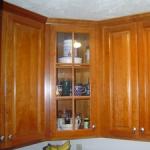Homemade heating boilers from a gas cylinder. DIY gas potbelly stove: a stove in a few hours
One of the easiest and cheapest ways to heat a summer house or garage is wood heating, for which homemade long-burning stoves are used. These are primitive metal furnaces with some refinement, which allows to increase the efficiency of burning solid fuel. In this article we will tell you how to make such a potbelly stove with your own hands from a gas cylinder, as well as correctly install it and connect the chimney.
The scheme and principle of operation of the stove
The history of these heating units is rooted in the beginning of the last century, when they were used to heat rooms in houses and even apartments. Such popularity is explained by the primitiveness of the device of the stove and the simplicity of manufacture. But this simplicity negatively affects the efficiency of its work, because the efficiency of the traditional stove is hardly exceeded 45%. Therefore, today it is used mainly for periodic heating of cottages and garages.
Initially, the heater was a metal case with a door for laying firewood and blown from one end, and a chimney was welded to the rear. There was no grate; fuel burned directly on the bottom (bottom). At the same time, the lion's share of the heat left the room through the chimney, since the hot combustion products got there directly from the firebox. To understand the device and the principle of operation of such a stove, it is worth studying the following scheme:
As you can see, incandescent flue gases containing a large amount of heat immediately leave the body of the furnace and are not used to heat the room. Later, the design was finalized by unknown craftsmen in order to take this heat away, as a result of which there were such varieties of bourgeois on wood:
- oven with grates and smoke circuits;
- long-burning heater, where the process of burning wood occurs from top to bottom.
Note. For additional heat removal from the chimney pipe, a water heat exchanger of the samovar type began to be installed on it, which will be discussed later.
The two-way wood-burning stove, whose drawing is shown below, has a grate and 2 partitions, forcing the flue gases to make a winding path inside the case before going outside. Thanks to this, the stove becomes more economical, since the combustion products have time to exchange heat with the surrounding air through the metal walls of the unit.
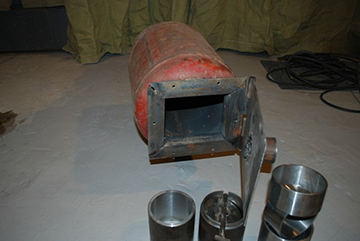
There is also the option of a round stove with one smoke flow, where the afterburning of pyrolysis gases takes place. This potbelly stove is intended for burning sawdust and small wood waste. There is a double-walled construction and the lower location of the chimney pipe, since gases must pass from the firebox from top to bottom in order to give off heat. The principle of operation of such a homemade potbelly stove is depicted in the diagram:
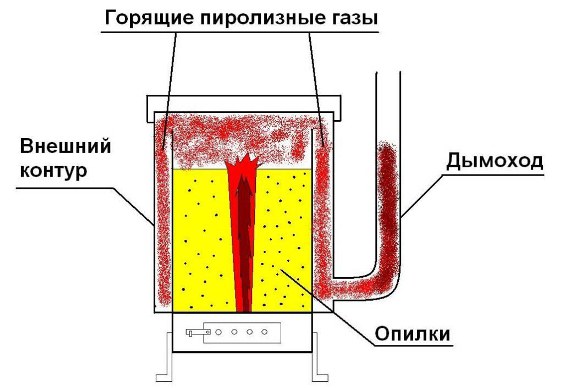
Another design, where solid fuel is burned from top to bottom, is not so economical, but it works with one bookmark much longer. Firewood is set on fire and burned from above, pressed by a load with a pipe through which air enters. How such a long-burning stove is functioning is shown in the diagram:

For reference. The people call this unit nothing more than the Bubafony furnace.
The topic of making various bourgeois on wood from gas cylinders is very popular and that's why. Firstly, it is an accessible material that can be found at any scrap metal collection point. Secondly, such a tank is the actual finished furnace body with fairly thick walls. It remains only to independently modify it and you will get an excellent potbelly stove for heating a garage or a summer residence. Moreover, the design can be both vertical and horizontal.
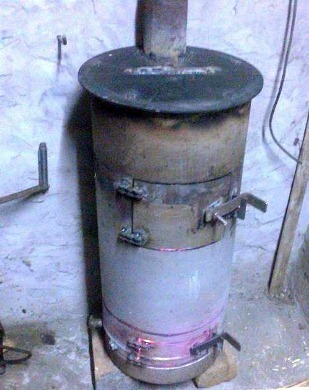
Tip. Most of all, for the manufacture of a home-made heater, a standard propane cylinder with a capacity of at least 50 liters is suitable. The use of smaller tanks will not give the desired effect, the stove will turn out to be heavy, and the heat exchange surface area will be small.
Do-it-yourself vertical potbelly stove from a cylinder is more compact and takes up little space in the room. But firewood in it will not burn for a long time, no matter how you limit the air flow, since the flame will cover the entire volume of fuel.
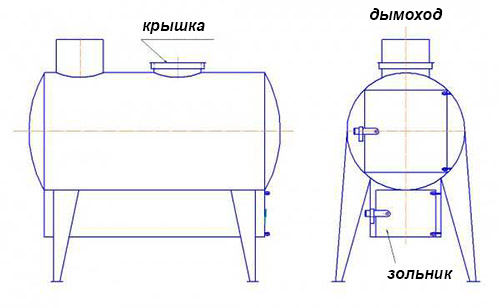
Another thing is a horizontal stove, in it the flame moves from beginning to end, gradually burning wood. But with it there is more work, you need to arrange an ash chamber outside, since inside it will take up too much usable volume. The device of this potbelly stove is shown in the drawing:

Now about how to make a horizontal potbelly stove at home. To do this, carefully cut off the top of the cylinder with a grinder, where the gas valve is screwed. Naturally, the valve must first be unscrewed, and the container filled with water to the top in order to displace all the propane vapor that could remain inside the tank.

Otherwise, you risk staging an explosion, the consequences of which are unpredictable. Then the sequence of actions is as follows:
- cut a strip in the side wall where the ash chamber will be welded. Another option is to drill a lot of holes, as seen in the photo below.
- to make and weld an ash pan from a metal 2-3 mm thick to the cylinder. Put a homemade door or flap on the front to regulate the air supply;
- in front, the loading door should be inserted into the end. It can be made round or square, or purchased the finished product;
- in the back you need to cut a hole for the chimney duct. Too big it is not worth doing, it is enough to accept the diameter of the chimney 100 mm, a maximum of 150;
- weld pipe;
- make a stand from any metal rolling stock and also weld it to the body.
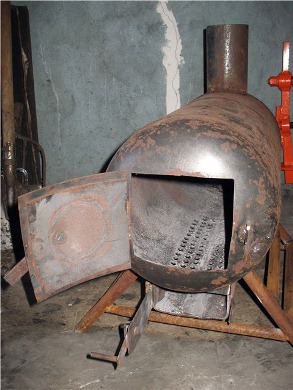
It is a little simpler to make an oven of vertical type from a cylinder. To make such a potbelly stove with your own hands, you need to cut openings for doors in the side wall, and the cut pieces of metal themselves can act as sashes. It is only necessary to attach loops to them, for example, from several links of the thick chain, as is done in the photo:
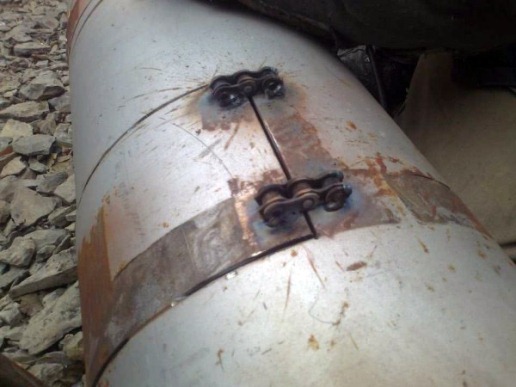
But with grate you have to tinker. Not only does it need to make a grill (preferably from a reinforcement of a periodic profile), so it still needs to be somehow installed inside the cylinder. Here you have to cut off its top or bottom - at your discretion.

After installing the grate, the cut-off part should be welded into place, and a pipe should be fitted on top to discharge the combustion products.

Note. Instead of a cut hemisphere, it is easier to put a flat lid of iron sheet. However, the pipe does not have to be mounted on top. It can be embedded in the wall of the potbelly stove in the upper part.
About the upper combustion stove
To make this type of stove, you need to collect its inner part - a load with a pipe for supplying air. It should be round in shape with a diameter such that it fits freely inside the container. Usually this is thick sheet metal (at least 10 mm) with a hole in the middle where the pipe is welded. On the underside, for better distribution of air in the combustion chamber, the potbelly stoves attach several ribs, this is clearly shown in the photo:
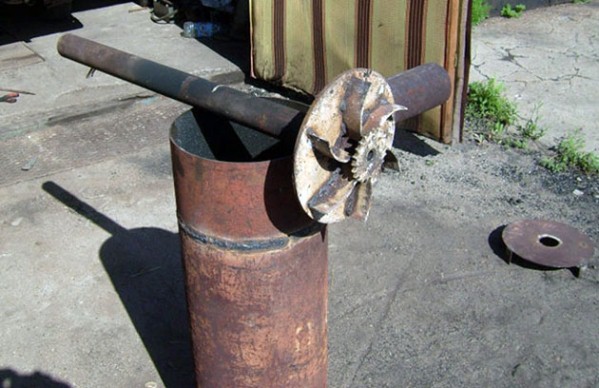
As in the previous version, you should cut off the upper part of the container and make a hole in the middle for the passage of the pipe. In order for the future lid to close tightly, it must be round-welded with a steel strip. The chimney pipe cuts into the side, in the upper part of the furnace body. How to make a potbelly stove of long burning, where the process goes from top to bottom, is described in detail in the video:
How to make a chimney for a stove
For the stable operation of this kind of home-made stoves, it is important to provide good traction. To do this, a section of the chimney pipe of a potbelly stove made of a cylinder should be at a height of at least 4 m above the grate. With a lateral connection of the gas duct, the minimum length of the horizontal section should be 400 mm, and condensate discharge must be arranged at the bottom of the vertical part, as shown in the figure:
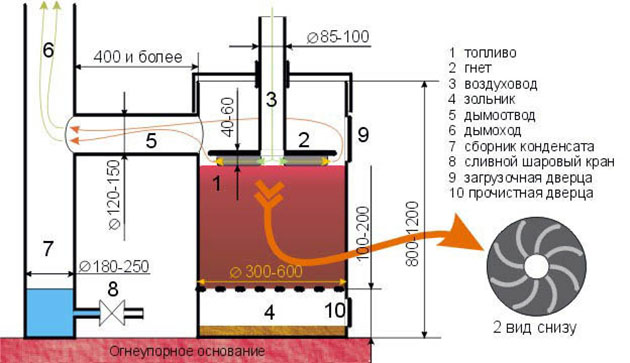
At the same time, it is advisable to take measures to efficiently remove heat from the gas duct. There are 2 proven ways to do this:
to install the horizontal section of the chimney from the potbelly stove at an inclination of 30-45 °, drawing it along the wall. After that, the channel turns up and goes outside;
a chimney mounted or a home-made water heat exchanger of a samovar type.
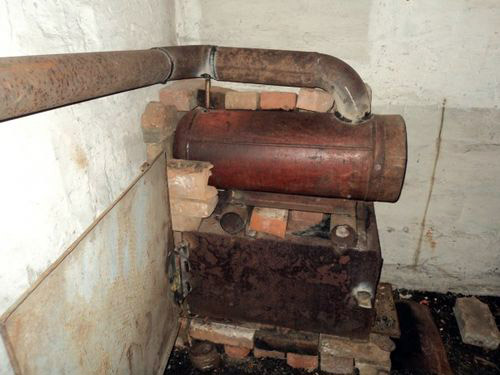
A pipe coming out of a potbelly stove at an angle and passing through the entire room will have time to transfer a significant amount of heat to the internal air, which will increase the overall efficiency of the stove, and reduce the consumption of firewood. In turn, a chimney with a water circuit will allow you to put 2-3 small radiators in the country and provide them with heat. The device is quite simple to manufacture: a water shirt with two nozzles is made in the duct section.

Tip. Circulation in the water circuit mounted on the chimney of the potbelly stove is better ensured by means of a circulation pump.
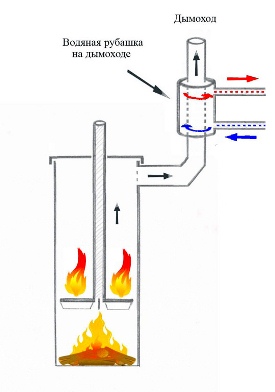
Conclusion
For heating cottages, garages and greenhouses, it is difficult to find a more profitable option than a home-made wood stove from a gas cylinder. Compared to electricity and gas, burning wood is much cheaper, even taking into account the low efficiency of these units. In addition, the efficiency of the potbelly stove can be improved by properly organizing the removal of combustion products and the selection of heat.
The cylinder is an excellent starting material for the construction of the furnace.
To help is its shape, alloy and metal thickness.
The simple design can easily be done independently, and even in several variations.
The main thing is the choice of a suitable cylinder and the necessary model of the stove for your goals, the ability to work with welding will also be useful.
The device of the gas cylinder furnace
Solid fuel furnaces of different types have similar structural elements:
- a blower, the functionality of which is the air supply to maintain the combustion process (location - in the lower part of the cylinder);
- the furnace is the place where the fuel burns (located above the blower);
- the chimney is a structure that displays combustion products on the street.
The blower and the firebox have separate doors, which allows you to bookmark firewood and control the intensity of combustion. The chimney is mounted separately, but it must be connected to the hole in the stove. You can improve the design of the outlet pipe by installing a wedge-shaped shutter, which regulates heat transfer.
Types of stoves from a cylinder
For heating household buildings of non-residential use;
For heating and cooking;
Country model for cooking;
Portable version of a multifunctional oven.
Popular models
The potbelly stove has a simple design, but this does not reduce its functional abilities. A small-sized oven is installed in almost any room. The connected chimney comes out. A circle or wire rack is welded to the top, which makes it possible to use the oven for cooking. The disadvantage is the rapid burning of the metal, especially with frequent use.
Read also: Cardan lamps (photo): device, types, advantages and disadvantages
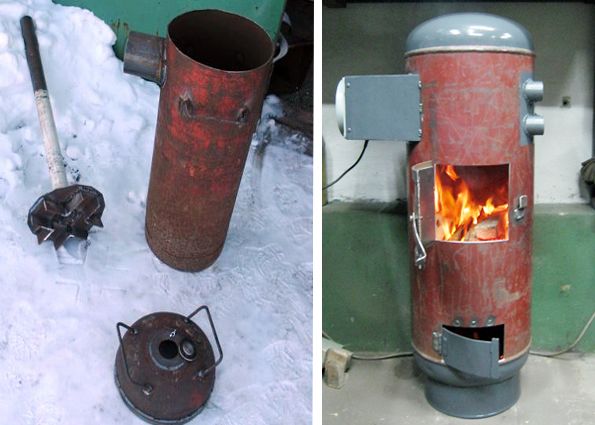 With used oil, the stove can heat a garage or a small country house. Its design has a more complex device than a potbelly stove. During operation, a peculiar hum is formed, and the impurities of the fuel emit a lot of soot and soot, so during use you need to regularly clean the chimney. But the advantages of this model overlap the listed disadvantages: the duration of combustion, high efficiency, easy maintenance and the duration of operation. Modernization of the furnace elements makes it possible to carry out heating of water and bring it to batteries. For the case, a typical cylinder of 50 l is suitable, but you should still check the wall thickness (should be at least 3 mm).
With used oil, the stove can heat a garage or a small country house. Its design has a more complex device than a potbelly stove. During operation, a peculiar hum is formed, and the impurities of the fuel emit a lot of soot and soot, so during use you need to regularly clean the chimney. But the advantages of this model overlap the listed disadvantages: the duration of combustion, high efficiency, easy maintenance and the duration of operation. Modernization of the furnace elements makes it possible to carry out heating of water and bring it to batteries. For the case, a typical cylinder of 50 l is suitable, but you should still check the wall thickness (should be at least 3 mm).
The Bubafon furnace is a model of long burning. It is especially popular among summer residents due to its high heat transfer and simple device. Frequent loading of fuel is not required, it is enough to put a new portion of firewood 1 time per day. Yes, and do it yourself from a gas cylinder is not a big deal.
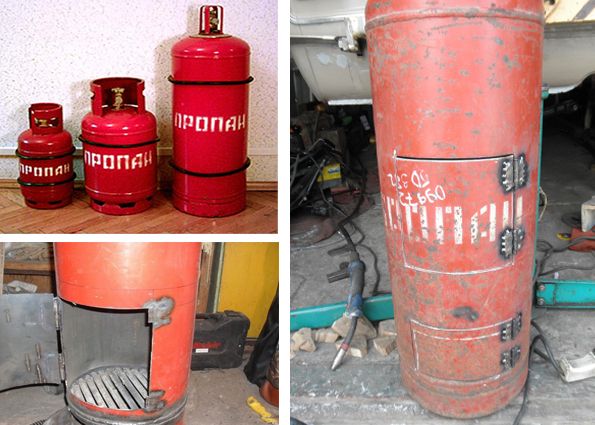
Cylinder selection
A cylinder made of a single sheet of metal is suitable for the basis of the future stove. The composite material has a low level of heat resistance, which indicates the danger of operation. Low-volume cylinders (5 l) will not be able to fully burn fuel, so they also need to be abandoned. Other models are used depending on the parameters:
Read also: Which air conditioner is better to choose for home? Types of air conditioners
12-27 liters are only suitable for small-sized portable furnaces and as a heat source in a small room (generated power is 3-7 kW);
50 l is an excellent option for heating and arranging the hob.
Among other cylinders, there are 40 liter ones for industrial gas, but it is not recommended to reconstruct them. And 10 liter containers are only suitable for portable models.
Each cylinder is equipped with a valve or valve. The valve is preferred, since this device will allow you to adjust the power when the air is supplied.

Preparation of the capacity for the furnace
For the base of the furnace it is not at all necessary to purchase a new cylinder, you can use the old one, the main thing is that it meets the requirements:
- one-piece durable housing;
- volume of 50 liters;
- lack of gas inside.
Disassembly should be carried out in a safe manner to prevent explosion. The first step is to release gas residues. After that, you can cut off the top of the cylinder, later it will come in handy as a structural element. You can get rid of unpleasant odors with a solution of chlorine (bleach). Rinse the walls of the container several times with bleach diluted in water. Persal is also suitable. Residues of the chemical compound are removed with a soda solution. After drying, the cylinder is ready for further alteration.
Read also: Blinds on the balcony (photo): device, functions, types, selection recommendations

The rules of operation of the furnace from a gas cylinder
During combustion, the tank surface heats up. In order to comply with safety rules, equip the installation site of the stove with metal sheets.
In long-burning models, a fuel moisture test should be performed to determine the best option.
If the stove has a chimney, you need to make it collapsible for easy maintenance.
Regularly clean combustion products.
Use only fuel intended for the furnace. Pouring combustible products into the solid fuel model is strictly prohibited.
Limit the access of children and animals to a heated container.
Do not install the stove close to a flammable surface.
Do not use flammable liquids for ignition.
It is necessary to enclose fuel in protective mittens to prevent burning.
It is forbidden to burn household and construction waste in the furnace.
It is undesirable to use wet firewood. During combustion, condensation will form, and settle on the working parts of the stove.
The proximity of a hot surface to combustible materials (gasoline, kerosene, wood, etc.) should be excluded.
Garden sprayer: types, tips on how to choose, with ...
How to choose a kitchen faucet? ...
Many people light up the idea of \u200b\u200bmaking a stove out of a gas cylinder with their own hands.
Such a heater will not require large financial investments, but it will be able to heat the technical room, greenhouse or stable.
Cylinders are different. For work, it is best to take a 50-liter tank. Its diameter is 30 cm, height 85 cm. The wall thickness is optimal.
There are even more thick-walled industrial cylinders of 40 liters. Diameter 25 cm. The cylinder will have to be cut in height, and thick walls contribute to longer heating, but also subsequent heat conservation.
What stoves can be made from a gas cylinder and how to do it right.
The barrel-shaped form is very versatile. Based on it you can collect:
- simple wood boilers, stoves;
- long burning, Bubafon, for example;
- liquid fuel furnace;
- stove for a bath with a stove.
It is clear that if you need a special bath stove, choosing a model is not worth it.
But if you plan to make a furnace for a summer house or technical room, it is worth deciding which design is best to do.
The potbelly stove is easy to manufacture, easy to use and maintain. But you can’t count on high efficiency.
Bubafonya is an analogue of the boilers of long burning Stropuva. They are effective, you need to replenish them with fuel less often than a conventional boiler. But the design requires careful calculation, the slightest violation of technology - and the combustion process will not go smoothly (attenuation, smoke, fast soot overgrowing are just some of the problems).
Even a good machine needs to learn how to properly heat and adapt to the "nature" of a particular instance. But it’s difficult to clean any long-burning furnace, especially its lower compartments. In addition, you can’t throw fuel into the combustion chamber until the combustion cycle is completed, and by connecting the Bubafon to the water jacket, we get unstable combustion and a decrease in efficiency.
It is not recommended to make a full-fledged gas-generating or pyrolysis furnace from a cylinder. In their production, structural steel is used, which does not have sufficient heat resistance.
Gas bottle preparation
The valve is twisted from the cylinder. This is the first and most important condition. In a sealed container, there is inevitably a gas residue and if you start to cut it, it is fraught with an explosion.

- The valve is twisting.
- An open container is washed with water and ventilated for at least a few weeks. The danger is only "fresh" cylinders. If it has been aired for a month or more, there will be no problems.
- If there is no time for airing, more extreme methods are used. After washing the bottle with a thick detergent, it is filled with water “to failure” and then cut with a grinder.
- Paint burns in the fire.
If the design of the heater requires a longitudinal section, you need to do it first, and then cross.
The walls of the container are energized, the metal turns sharply and can injure a person.
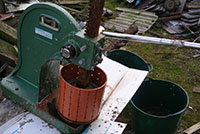 Agricultural waste is an excellent and literally free fuel. It is best to use this type of fuel in the form of briquettes. can do it yourself.
Agricultural waste is an excellent and literally free fuel. It is best to use this type of fuel in the form of briquettes. can do it yourself.
Tips for making portals for a fireplace with your own hands you will find.
Assembly
The procedure for the manufacture of the furnace:
- With a diameter of 30 cm, the height of the boiler is 90 cm, but the entire cylinder is 85. There are two solutions to the problem. Firstly, you can cut off the entire vaulted part and set the missing height with a fragment from another cylinder. Secondly, you can turn this vaulted part into a cover. The upper cut is done where the straight part of the hull begins.
- The press is made. A circle with a diameter of 27 cm is cut out of metal (6-10 mm thick). A hole is made in the center to fit the size of the duct pipe.
- The ribs are made 4 cm high. They are slightly bent and welded onto the pancake so that the bend goes clockwise.
- A door is cut in the lower part of the body - an ash pan with a width of 17 cm.
- Grid-irons. The grill can be welded separately from metal rods. The legs welded to it will help to place the grill at the right height. Their height is taken based on the height at which the ash pan door ends.
- Duct pipe. Diameter 7.5 - 8 cm. Its lower edge should protrude from the pressure sheet (reach the edge of the ribs). The top edge is 15 cm above the collar welded onto the cover. The pipe is welded to a round press with ribs.
- A shutter is made on the upper edge of the air supply pipe, with which the air supply is regulated. A bolt is welded along the outer wall of the pipe, and a hole is drilled in the flapper. The damper is rotary.
- Cap. Must dress tight. To do this, you can weld the bead ring along the outer edge of the body. It will be convenient if the lid and body are equipped with handles.
- In the center of the straight cover and at the top of the vaulted hole, a hole is made through which the duct will exit. Its diameter is equal to the outer diameter of the duct + the minimum clearance that will allow free passage of the pipe (no more than 2 mm).
- A collar is set around the perimeter of the hole. Its height is the size of the gap, increased by 80 times.
- Chimney. A pipe segment (40 cm or more in length) will be located horizontally and docked with a vertical chimney pipe (10 - 12 cm in diameter). Stepping back from the lid 1 - 2 cm down, a hole is cut equal to the diameter of the chimney, a short pipe is welded to it. This is the final stage of the manufacture of the furnace in the workshop. Further work is carried out after installation on site.
- Part of the chimney falls below the junction with the pipe and a device is made in it for collecting and draining condensate, which is inevitable in such furnaces.
- The chimney is passed through the roof and is welded to the stove.
To heat a home-made stove with coal is not advisable. The heat from this fuel is the strongest, and as already mentioned, the steel of the cylinder is not heat-resistant. And when the maximum warming up from firewood occurs, it is better to close the damper almost completely.
Conclusion
A potbelly stove is wasteful of fuel, and one load of fuel into the Bubafon is enough for almost a day. The most important thing is that any of these heating devices will cost a minimum of money, and they can afford heating buildings.
Related videos
Due to rising prices for gas and electricity, the use of solid fuels (firewood, coal, shale and woodworking waste) is becoming increasingly important. Having made a home-made pyrolysis boiler from a gas cylinder with your own hands, you can solve the problem of heating a fairly large room.
Pyrolysis and fuel economy
Pyrolysis divides wood into combustible gases and carbon. Combustion of light gases creates such a high temperature that a small amount of carbon monoxide and fine ash (ten times less than when burning ordinary wood in a stove) remain the waste of the process. Pyrolysis of wood takes more time and gives much more heat than the most efficient wood-burning stoves.
Gas cylinder pyrolysis boiler: device and principle of operation
Homemade pyrolysis boiler from a gas cylinder works according to the following principle:
- The fuel is loaded through the top of the boiler or the side door, set fire to a stable fire, covered with an air duct - a piston (popular name "pancake") and a tight top cover with an opening for a "pancake" pipe. The unusual design of the piston was the result of many experiments by heating engineers. The blades create vortex flows of air flowing through the pipe above the smoldering fuel, and the usual unusable sprocket welded over the "screw" serves as an obstacle to the appearance of open fire under the pipe (even a small flame can ruin the process)
- Fuel smolders under the yoke of "pancake", receiving a small influx of air from the duct pipe. Combustible gases rise from the smoldering fuel up along the walls of the boiler and burn in the upper part of the "furnace".
- Combustion products (carbon monoxide and vapor) exit through a side chimney in the upper part of the chamber (see diagram 1).
The dimensions of a standard gas cylinder of 50 liters (height -0.96m, diameter 0.3m) are optimally suitable for a medium-sized boiler. The maximum dimensions that are recommended for such an aggregate are: height - 1.2m, diameter - 0.6m.
Making a homemade pyrolysis boiler from a gas cylinder
Tools necessary for the manufacture of the boiler:
- Welding machine (household, at 220V), with 4 mm electrodes.
- Gas cutter.
- Angle grinder ("grinder") with an abrasive wheel for cleaning seams and deposited protrusions.
Materials:
- Gas cylinder (50 liters, propane).
- A sheet of metal sufficient for two circles in the diameter of the cylinder and two rectangular doors (6x15 and 15x20cm).
- A metal strip (thickness 3-4mm, width 40mm) for the blades on the pancake and welt on the top cover.
- 14mm fittings for grilles above the ash chamber.
Scheme 1: Pyrolysis boiler from a gas cylinder.
The cylinder is trimmed at the top from the start of rounding. If desired, the upper part can be turned into a cover: grind the incision for tightness, cut a hole for the piston pipe from above (the gap between the cover and the pipe should not exceed 2 - 3 mm) and weld the cover along the edge with a steel strip. A loading door is cut out on the side. The design should impede the passage of air into the chamber (therefore, it often costs to load through the top).
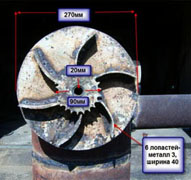 The chimney for the boiler is made of pipes of two diameters: lateral outlet from the body - 0.12-0.15 m, vertical - 0.18-0.2 m. The difference in diameters creates a two-stage draft, less active than in a pipe of the same diameter. A right angle also lowers the rate of gas exhaust. Due to lower pressure, the fuel burns out more slowly, maintaining a stable pyrolysis process for 8-10 hours.
The chimney for the boiler is made of pipes of two diameters: lateral outlet from the body - 0.12-0.15 m, vertical - 0.18-0.2 m. The difference in diameters creates a two-stage draft, less active than in a pipe of the same diameter. A right angle also lowers the rate of gas exhaust. Due to lower pressure, the fuel burns out more slowly, maintaining a stable pyrolysis process for 8-10 hours.
Photo 1: Piston: bottom view.
A grate is cooked from the fittings, through which the decayed fuel falls into the lower part of the boiler. A door is cut out at the bottom of the boiler to clean the ash chamber (the most dense vestibule is recommended).
Water vapor evaporated from the fuel condenses in a vertical pipe. For their removal into the vertical chimney a ball valve is welded (it is easily cleaned from pollution by wire).
The boiler perfectly burns slowly burning fuel: chips and sawdust from secondary waste, slow-burning shale and even raw firewood (50% humidity). That is why this unit is popular in the Baltic States, where there is no other fuel besides shale. Popularly, this home-made pyrolysis boiler made of a gas cylinder is called "bubafonya" (this is the nickname of its inventor).
A stove-potbelly stove is an excellent option for affordable and efficient heating of any warehouse or production room. Another plus of such a heating device is the ability to assemble it with your own hands from almost any improvised metal parts. But the most common version of a home-made heater was and remains a stove-potbelly stove made of a gas cylinder.
It does not take a lot of time to assemble such an apparatus, while it is able to serve without fail for many years, eliminating the problem of heating a warehouse, a barn, a garage or any other premises for industrial purposes.
The principle of operation of a gas stove from a gas cylinder
A home-made stove, like any solid fuel heater, consists of the following parts and assemblies:
| . This is a special channel located at the bottom of the furnace. Through it, air enters the combustion chamber, which serves as a catalyst for the combustion of fuel. The blower is necessarily equipped with a specific door, with which you can adjust the intensity of the combustion process, increasing or decreasing the clearance of the air channel. In addition, the blower serves as a container for collecting the smallest particles of combustion products - ash and ash. | |
| . This is a solid fuel combustion chamber, it is located above the blower. It is separated from the air channel by special grates - grates. The furnace is equipped with its own door, which is necessary for loading energy. Kindle fire in the furnace should be strictly with the door open and the air channel closed. During the operation of the stove, the products of fuel combustion pass through the grid-irons into the blower and, with the help of a chimney, are brought out. | |
| Chimney or exhaust duct. It is necessary for the removal of combustion products from the furnace and blower. The chimney is necessarily equipped with a view - a wedge-shaped shutter, which, if necessary, can block the exhaust duct. View helps slow down the process of energy combustion, which has a positive effect on the efficiency of the stove. |
If the stove body is made of a gas cylinder, then two components are mounted inside it: a furnace and a blower. An exhaust duct is connected to the potbelly stove outside.
The principle of operation of a solid fuel stove is as follows:
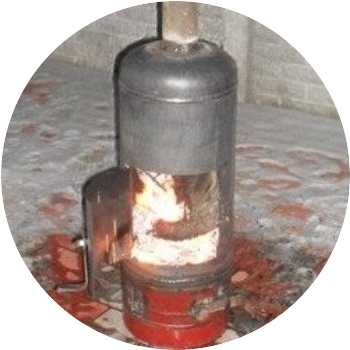 1. Air is blown into the furnace through the blower.
1. Air is blown into the furnace through the blower.
2. Solid fuel (firewood, coal, briquettes) burns in the furnace.
3. Combustion products and carbon monoxide are discharged through the chimney.
The intensity of combustion is regulated using a special throttle valve, which is mounted in the fitting located at the entrance to the blower, as well as a wedge-shaped view, which is installed in the body of the exhaust channel.
The fueling is made through a special door located on the cylinder body.
How to make a stove from a gas cylinder with your own hands
As a rule, a homemade potbelly stove is assembled on the basis of a fifty-liter red cylinder, which is designed to store propane or a propane-butane mixture. This type of cylinder is actively used both in everyday life for connecting gas stoves in the absence of main gas, and in production for storage of energy carrier that feeds the gas cutter. Difficulties with finding a cylinder of the required volume should not arise.

Gas bottle preparation
Before proceeding with the assembly of the potbelly stove, it is necessary to make a "semi-finished product" from the cylinder, which is done according to the following scheme:
Residual gas is vented from the cylinder. To do this, open the shut-off valve and wait until the characteristic hiss stops. Gas must be vented in the fresh air, in no case should this be done indoors.
It is necessary to get rid of the specific “gas” odor of the odorant - a mercaptan perfume, which is added to the gas for easier detection of its leaks. This is done quite simply: the “shoulder” bottle is filled with an aqueous solution of any oxygen bleach, the precipitate formed is simply washed off with a 10% solution of soda ash.
After the manipulations, the balloon is ready to assemble the stove.
The choice of the design of the potbelly stove
A home-made solid fuel stove can be of two types:
That is, a body made of a gas cylinder is either in the usual vertical position with the valve up and rests on the ring support, or lies sideways with the valve and rests on legs that are welded to the body.
Making a horizontal potbelly stove takes less time, but the finished product takes up more space, while the vertical version fits easily in any corner, and the traction in it will be better.
Assembly of a horizontal stove-potbelly stove
Stages of assembling a horizontal stove from a gas cylinder:
1. The upper part, where the valve was previously located, is cut off from the cylinder at the level of “shoulders”.
2. Legs are welded to the cylindrical body, which give the stove stability in the horizontal position.
 3. A round hole is made in the upper part of the casing from the closed end side, to which a chimney will be connected in the future. After that, an annular “collar” is welded over the hole, which is made of a strip of steel 5 cm wide.
3. A round hole is made in the upper part of the casing from the closed end side, to which a chimney will be connected in the future. After that, an annular “collar” is welded over the hole, which is made of a strip of steel 5 cm wide.
4. Horizontal grates are installed inside the cylinder, the distance from which to the lower point of the circumference of the body must be equal to ¼ of the diameter of the cylinder. To make the installation process more convenient, in the cylinder wall, you can pre-make holes for the grate rods, which are subsequently mounted with an annular weld from the outside. You can install the grate inside the casing in another way: by welding inside two shelves from the corners on which to put the grate. This option looks more preferable, since the replacement of burned grate in this case is simpler and faster than with the insert.
5. A steel sheet is welded to the front side of the container, in which an opening is cut out under the door and a fitting with a ball valve is welded, which will be used as a blower. The door to the case is fastened with hinges and equipped with a latch for tight closing. There is also an alternative option, which requires mounting around 10 cm wide annular belt around the body of the ring. In this case, the ring belt is mounted both on the inside and on the outside of the body, forming a gap for installing a hemisphere cut from the top of the container, which will serve as a door into the combustion chamber. In this case, the hole for the valve equipped with a throttle or ball lock serves as a blower.
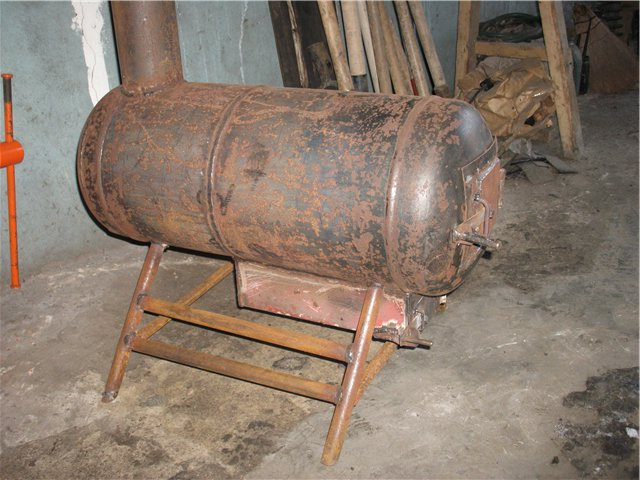
It is only necessary to install such a stove on a steel sheet, the width of which is not less than a meter and the length of not less than one and a half meters, while in front of the door to the combustion chamber there should be a platform with a length of at least half a meter.
Assembly of a vertical stove-potbelly stove
Stages of assembly of a vertical gas cylinder stove:
1. The hole in the end part, where the valve was previously located, expands to 10 centimeters in diameter. A metal plate with a thickness of at least 5 cm is annularly welded along its edges; it will serve as a branch pipe of the exhaust channel.
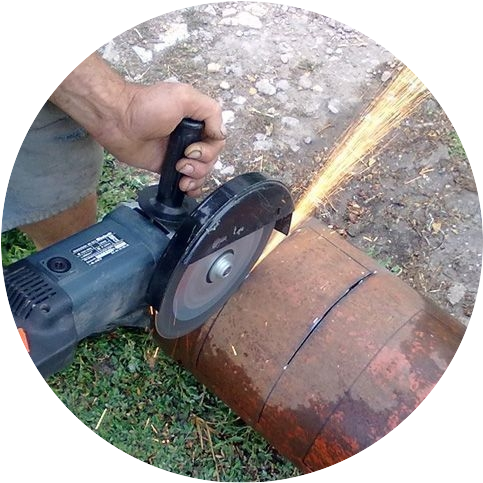 2. At a level of not more than 10 centimeters from the bottom of the cylinder, an opening is cut out under the door for the blower, and a little higher is the hole for the door of the combustion chamber. The size of the holes can be any, but the area of \u200b\u200bthe blower door cannot be less than the area of \u200b\u200bthe chimney pipe.
2. At a level of not more than 10 centimeters from the bottom of the cylinder, an opening is cut out under the door for the blower, and a little higher is the hole for the door of the combustion chamber. The size of the holes can be any, but the area of \u200b\u200bthe blower door cannot be less than the area of \u200b\u200bthe chimney pipe.
3. Between the blower and the firebox horizontal shelves are installed on which the grate is placed.
4. The doors of the stove are hinged and equipped with latches.
You can install such a stove on a steel sheet measuring 70x100 cm.
This design of the furnace involves the installation of the so-called "broken" chimney, which prevents the discharge of a large amount of heat through the exhaust duct.






